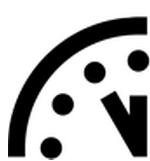Doomsday Clock moves 1 minute closer to midnight
January 11, 2012
Faced with inadequate progress on nuclear weapons reduction and proliferation, and continuing inaction on climate change, the Bulletin of the Atomic Scientists (BAS) announced today that it has moved the hands of its famous “Doomsday Clock” to five minutes to midnight.
The last time the Doomsday Clock minute hand moved was in January 2010, when the Clock’s minute hand was pushed back one minute from five to six minutes before midnight.
The Bulletin of the Atomic Scientists noted: “It is five minutes to midnight. Two years ago, it appeared that world leaders might address the truly global threats that we face. In many cases, that trend has not continued or been reversed. For that reason, the Bulletin of the Atomic Scientists is moving the clock hand one minute closer to midnight, back to its time in 2007.”
“Unfortunately, Einstein’s statement in 1946 that ‘everything has changed, save the way we think,’ remains true,” said Lawrence Krauss, who is co-chair, BAS Board of Sponsors; foundation professor, School of Earthand Space Exploration and Physics departments; associate director, Beyond Center; co-director, Cosmology Initiative and director, New Origins Initiative, Arizona State University.
“Faced with clear and present dangers of nuclear proliferation and climate change, and the need to find sustainable and safe sources of energy, world leads are failing to change business as usual. Inaction on key issues including climate change, and rising international tensions motivate the movement of the clock. As we see it, the major challenge at the heart of humanity’s survival in the 21stcentury is how to meet energy needs for economic growth in developing and industrial countries without further damaging the climate, exposing people toloss of health and community, and without risking further spread of nuclear weapons, and in fact setting the stage for global reductions.”
More than 19,000 nuclear weapons
“Despite the promise of a new spirit of international cooperation, and reductions in tensions between the United States and Russia, the Science and Security Board believes that the path toward a world free of nuclear weapons is not at all clear, and leadership is failing,” said Jayantha Dhanapala, member, BAS Board of Sponsors, former United Nations under-secretary-general for Disarmament Affairs (1998-2003), and ambassador of Sri Lanka to the United States (1995-7).
“The ratification in December 2010 of the New START treaty between Russia and the United States reversed the previous drift in US-Russia nuclear relations. However, failure to act on the Comprehensive Test Ban Treaty by leaders in the United States, China, Iran, India, Pakistan, Egypt, Israel, and North Korea on a treaty to cut off production of nuclear weapons material continues to leave the world at risk from continued development of nuclear weapons. The world still has over 19,000 nuclear weapons, enough power to destroy the world’s inhabitants several times over.”
BAS noted that other key recommendations for a safer world have not been taken up and require urgent attention, including:
- Ratification by the United States and China of the Comprehensive Test Ban Treaty and progress on a Fissile Material Cutoff Treaty;
- Implementing multinational management of the civilian nuclear energy fuel cycle with strict standards for safety, security, and nonproliferation of nuclear weapons, including eliminating reprocessing for plutonium separation;
- Strengthening the International Atomic Energy Agency’s capacity to oversee nuclear materials, technology development, and its transfer;
- Adopting and fulfilling climate change agreements to reduce carbon dioxide emissions through tax incentives, harmonized domestic regulation and practice;
- Transforming the coal power sector of the world economy to retire older plants and to require in new plants the capture and storage of the CO2 they produce; and
- Vastly increasing public and private investments in alternatives to carbon emitting energy sources, such as solar and wind, and in technologies for energy storage, and sharing the results worldwide.
Click here for a full copy of the BAS statement about the Doomsday Clock. Click here for the full program for the January 9th symposium.

